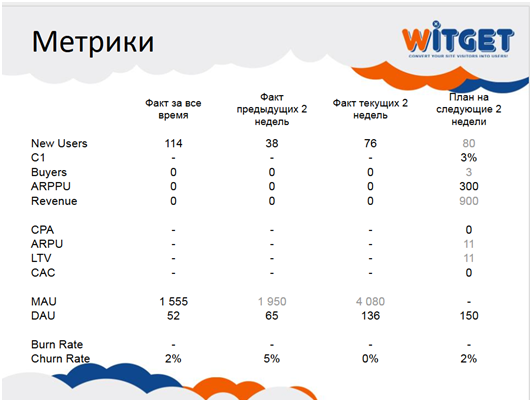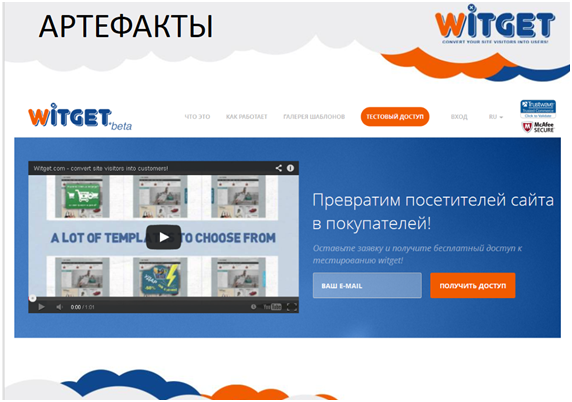How do traction rallies save startups from failure
Traction literally means “traction” or “traction force”. And in the world of startups “traction” - an assessment of how the team manages to translate the business model into reality. Simply put, traction is the “grip” of a startup with its road map.
Why do we need traction meetings
Traction meetings arrange all kinds of accelerators and seed funds. It is also possible to hold internal tracking meetings in the company, when the whole team reports to investors or departments report to each other.
')
At such reporting meetings, a startup most often shows that he has everything in order with this very clutch and he does not “slip”.

Investors need physical evidence in numbers, cases, opinions that the project has a chance of success and becoming an independent sustainable company.
But the beauty of these “reporting meetings” is not the point: they, first of all, mobilize and organize the work of the team itself. After a traction rally, a plan is drawn up for the next 2-3 weeks in the head.
Treshn is especially important for startups in the field of IT, who need to raise funds in the early stages of development. Therefore, accelerators, for example, IIDF , require startups to report as part of a traction rally every 2 weeks.
FRII is distinguished by the fact that startups do not just give money, but help to go all the way from idea to monetization. Experts are involved for this - businessmen, consultants, investors. Each project has a mentor who, including with the help of traction meetings, monitors the proper development of a startup. Mentor harsh, fair, but most importantly - useful. Experts not only share their successful experience, but can even help with legal and technological issues.
In this case, the traction for each individual product may imply different parameters and basic metrics. Typically, metrics are based on financial information that reflects a high propensity to purchase a product.
Tracking presentation structure
The Witget project , the designer of conversion enhancement tools, follows a specific list of parameters that should be reflected in the presentation at the traction rally.
1) The first thing that your presentation must contain is metrics . The slide reflects the facts for the entire existence of the startup, for the previous and current period and, of course, the plan for the coming weeks. Metrics is a list of key values for a startup. Such as, for example, ARPPU - the indicator of project profitability per one paying user, or DAU and MAU - the ratio of daily active users to monthly.
In this case, the slide shows the total amount for all time, as well as the fact of the previous 2 weeks, current 2 and plan. Thus, we can trace the dynamics of development.

2) The next step is hypotheses and results . The slide is built from 4 components:
• what you planned to change
• what it should affect (which metrics and metrics)
• what did you do for this
• what came of it
These hypotheses were announced 2 weeks ago. In this format, the project reports on how to test the stated hypotheses.

3) Artifacts are an object created by the hands or the mind of a person, i.e. any physical or visual proof of work. This could be a sales funnel, a print screen of a sent newsletter, a review of your work, a video, photos from a promotion that you conducted, and survey data. If you have an offline business, then this may be a sample of products, an example of packaging, the design of the product itself. The advantages of artifacts are that this is a reason for pride, a kind of motivator for the team.
As an example - a new landing project and Witget , which has replaced the old one. The artifact confirmed our hypothesis that a new landing page with video, a bright button on the main and menu item “Test Access” will raise the conversion to 20%.

4) Devote the last three slides to the results:
• The main findings of the period - your exploits, flaws, general results on the results of testing hypotheses. In general, this is the same thing that you showed before, but more clearly.
For example, you posted 2 paid reviews of your new iPhone app. In all, they brought you 100 installations for $ 10 each. This you reflected in the results of the hypotheses. In general conclusions we can say, for example, that the first review worked better, that after the second there were many questions regarding your main competitor. Accordingly, it is necessary to clear up from similar decisions more clearly and write more about the benefits for customers.

• Plans for the next period - put here hypotheses that you will defend next time. They must be real and thought out in advance.
Important! Tasks and plans are not the following: “Create an application for iPhone”, “Place a new video on the landing page”, “Make a user guide for customers”. These are process tasks, the result of which - did or did not do, but it is not clear whether they have influenced your business for the better or for the worse.
Tasks must be tied to metrics and indicators. For example, “A new instruction will reduce the churn rate (customer churn) by 10%,” “A new video on the landing page will increase the conversion to registration by 7%.” “Having an application for iPhone will increase the average total time spent by the client in service by 30 seconds. Or if, on average, a customer came to the service 1 time at 6 o'clock, then now it will go 1 time at 4, 5 hours. The more accurately you set the objectives, the closer you are to the goal of making a profit from your business.
• Needs - state both for yourself and the mentor what you lack to achieve goals. These can be requests, wishes, in which colleagues, partners, mentors can assist.
Needs may relate to the following aspects:
- associate with the right person (decision maker - decision maker),
- advise the employee for your vacancy,
- share data, statistics,
- domestic needs: together to rent an office, buy used equipment from another startup, etc.
At the end of the rally, your mentors or trackers ask questions related to the presentation, business in general and your plans. Answers to questions will help you better understand your startup, will give food for thought.
Following the results of your performance, the audience usually writes down comments, tips, wishes in a single file open for all - “Form 360 (degrees)”. The purpose of the form is to make you think and develop, so even if you are criticized, treat it with respect and do not reject it. A side view is one of the key benefits of a traction rally. Everything recorded in it, you need to adopt and boldly work on it on a startup!
Why do we need traction meetings
Traction meetings arrange all kinds of accelerators and seed funds. It is also possible to hold internal tracking meetings in the company, when the whole team reports to investors or departments report to each other.
')
At such reporting meetings, a startup most often shows that he has everything in order with this very clutch and he does not “slip”.

Investors need physical evidence in numbers, cases, opinions that the project has a chance of success and becoming an independent sustainable company.
But the beauty of these “reporting meetings” is not the point: they, first of all, mobilize and organize the work of the team itself. After a traction rally, a plan is drawn up for the next 2-3 weeks in the head.
Treshn is especially important for startups in the field of IT, who need to raise funds in the early stages of development. Therefore, accelerators, for example, IIDF , require startups to report as part of a traction rally every 2 weeks.
FRII is distinguished by the fact that startups do not just give money, but help to go all the way from idea to monetization. Experts are involved for this - businessmen, consultants, investors. Each project has a mentor who, including with the help of traction meetings, monitors the proper development of a startup. Mentor harsh, fair, but most importantly - useful. Experts not only share their successful experience, but can even help with legal and technological issues.
In this case, the traction for each individual product may imply different parameters and basic metrics. Typically, metrics are based on financial information that reflects a high propensity to purchase a product.
Tracking presentation structure
The Witget project , the designer of conversion enhancement tools, follows a specific list of parameters that should be reflected in the presentation at the traction rally.
1) The first thing that your presentation must contain is metrics . The slide reflects the facts for the entire existence of the startup, for the previous and current period and, of course, the plan for the coming weeks. Metrics is a list of key values for a startup. Such as, for example, ARPPU - the indicator of project profitability per one paying user, or DAU and MAU - the ratio of daily active users to monthly.
In this case, the slide shows the total amount for all time, as well as the fact of the previous 2 weeks, current 2 and plan. Thus, we can trace the dynamics of development.

2) The next step is hypotheses and results . The slide is built from 4 components:
• what you planned to change
• what it should affect (which metrics and metrics)
• what did you do for this
• what came of it
These hypotheses were announced 2 weeks ago. In this format, the project reports on how to test the stated hypotheses.

3) Artifacts are an object created by the hands or the mind of a person, i.e. any physical or visual proof of work. This could be a sales funnel, a print screen of a sent newsletter, a review of your work, a video, photos from a promotion that you conducted, and survey data. If you have an offline business, then this may be a sample of products, an example of packaging, the design of the product itself. The advantages of artifacts are that this is a reason for pride, a kind of motivator for the team.
As an example - a new landing project and Witget , which has replaced the old one. The artifact confirmed our hypothesis that a new landing page with video, a bright button on the main and menu item “Test Access” will raise the conversion to 20%.

4) Devote the last three slides to the results:
• The main findings of the period - your exploits, flaws, general results on the results of testing hypotheses. In general, this is the same thing that you showed before, but more clearly.
For example, you posted 2 paid reviews of your new iPhone app. In all, they brought you 100 installations for $ 10 each. This you reflected in the results of the hypotheses. In general conclusions we can say, for example, that the first review worked better, that after the second there were many questions regarding your main competitor. Accordingly, it is necessary to clear up from similar decisions more clearly and write more about the benefits for customers.

• Plans for the next period - put here hypotheses that you will defend next time. They must be real and thought out in advance.
Important! Tasks and plans are not the following: “Create an application for iPhone”, “Place a new video on the landing page”, “Make a user guide for customers”. These are process tasks, the result of which - did or did not do, but it is not clear whether they have influenced your business for the better or for the worse.
Tasks must be tied to metrics and indicators. For example, “A new instruction will reduce the churn rate (customer churn) by 10%,” “A new video on the landing page will increase the conversion to registration by 7%.” “Having an application for iPhone will increase the average total time spent by the client in service by 30 seconds. Or if, on average, a customer came to the service 1 time at 6 o'clock, then now it will go 1 time at 4, 5 hours. The more accurately you set the objectives, the closer you are to the goal of making a profit from your business.
• Needs - state both for yourself and the mentor what you lack to achieve goals. These can be requests, wishes, in which colleagues, partners, mentors can assist.
Needs may relate to the following aspects:
- associate with the right person (decision maker - decision maker),
- advise the employee for your vacancy,
- share data, statistics,
- domestic needs: together to rent an office, buy used equipment from another startup, etc.
At the end of the rally, your mentors or trackers ask questions related to the presentation, business in general and your plans. Answers to questions will help you better understand your startup, will give food for thought.
Following the results of your performance, the audience usually writes down comments, tips, wishes in a single file open for all - “Form 360 (degrees)”. The purpose of the form is to make you think and develop, so even if you are criticized, treat it with respect and do not reject it. A side view is one of the key benefits of a traction rally. Everything recorded in it, you need to adopt and boldly work on it on a startup!
Source: https://habr.com/ru/post/225049/
All Articles